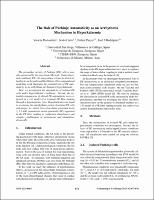Please use this identifier to cite or link to this item:
https://repositorio.usj.es/handle/123456789/515
| Title: | The Role of Purkinje Automaticity as an Arrhythmia Mechanism in Hyperkalaemia |
| Authors: | Monasterio, Violeta



Carro, Jesús 


Pueyo, Esther 


Rodríguez, José F. 

|
| Keywords: | Ischemia |
| Issue Date: | Sep-2015 |
| Publisher: | IEEE, 345 E 47TH ST, NEW YORK, NY 10017 USA |
| Citation: | V. Monasterio, J. Carro, E. Pueyo and J. F. Rodríguez, "The role of purkinje automaticity as an arrhythmia mechanism in hyperkalaemia," 2015 Computing in Cardiology Conference (CinC), Nice, France, 2015, pp. 873-876, doi: 10.1109/CIC.2015.7411050. |
| Abstract: | The pacemaker activity of Purkinje (PK) cells is usually suppressed by the sino-atrial (SA) node. Under abnormal conditions, PK cells may produce ectopic focal activity leading to tachycardia and fibrillation. This computational modelling work illustrates the potential role of PK automaticity as an arrhythmia mechanism in hyperkalaemia. First, we investigated the automaticity of isolated PK cells under hyperkalaemic conditions. Second, the potential consequences of altered PK automaticity were explored in a 1-D model of a terminal PK fibre running through a hyperkalaemic zone. Hyperkalaemia was found to accelerate the autorhythmic period of isolated PK cells with respect to control. For extracellular potassium levels >= 7.2 mM, spontaneous action potentials (APs) appeared in the PK fibre, leading to conduction disturbances and complex combinations of spontaneous and stimulation-driven APs. |
| Description: | Colección: Computing in Cardiology Conference |
| URI: | https://repositorio.usj.es/handle/123456789/515 |
| ISBN: | 978-1-5090-0685-4 |
| Appears in Collections: | Comunicaciones a congresos, conferencias |
Files in This Item:
| File | Description | Size | Format | |
|---|---|---|---|---|
| The Role of Purkinje Automaticity as an Arrhythmia.pdf | 1,06 MB | Adobe PDF |  View/Open |
This item is licensed under a Creative Commons License

